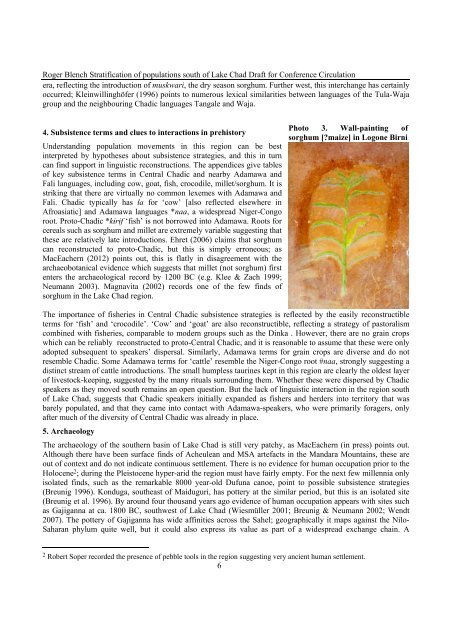Linguistic evidence for the chronological ... - Roger Blench
Linguistic evidence for the chronological ... - Roger Blench
Linguistic evidence for the chronological ... - Roger Blench
Create successful ePaper yourself
Turn your PDF publications into a flip-book with our unique Google optimized e-Paper software.
<strong>Roger</strong> <strong>Blench</strong> Stratification of populations south of Lake Chad Draft <strong>for</strong> Conference Circulation<br />
era, reflecting <strong>the</strong> introduction of muskwari, <strong>the</strong> dry season sorghum. Fur<strong>the</strong>r west, this interchange has certainly<br />
occurred; Kleinwillinghöfer (1996) points to numerous lexical similarities between languages of <strong>the</strong> Tula-Waja<br />
group and <strong>the</strong> neighbouring Chadic languages Tangale and Waja.<br />
4. Subsistence terms and clues to interactions in prehistory<br />
Understanding population movements in this region can be best<br />
interpreted by hypo<strong>the</strong>ses about subsistence strategies, and this in turn<br />
can find support in linguistic reconstructions. The appendices give tables<br />
of key subsistence terms in Central Chadic and nearby Adamawa and<br />
Fali languages, including cow, goat, fish, crocodile, millet/sorghum. It is<br />
striking that <strong>the</strong>re are virtually no common lexemes with Adamawa and<br />
Fali. Chadic typically has ɬa <strong>for</strong> ‘cow’ [also reflected elsewhere in<br />
Afroasiatic] and Adamawa languages *naa, a widespread Niger-Congo<br />
root. Proto-Chadic *kɨrɨf ‘fish’ is not borrowed into Adamawa. Roots <strong>for</strong><br />
cereals such as sorghum and millet are extremely variable suggesting that<br />
<strong>the</strong>se are relatively late introductions. Ehret (2006) claims that sorghum<br />
can reconstructed to proto-Chadic, but this is simply erroneous; as<br />
MacEachern (2012) points out, this is flatly in disagreement with <strong>the</strong><br />
archaeobotanical <strong>evidence</strong> which suggests that millet (not sorghum) first<br />
enters <strong>the</strong> archaeological record by 1200 BC (e.g. Klee & Zach 1999;<br />
Neumann 2003). Magnavita (2002) records one of <strong>the</strong> few finds of<br />
sorghum in <strong>the</strong> Lake Chad region.<br />
Photo 3. Wall-painting of<br />
sorghum [?maize] in Logone Birni<br />
The importance of fisheries in Central Chadic subsistence strategies is reflected by <strong>the</strong> easily reconstructible<br />
terms <strong>for</strong> ‘fish’ and ‘crocodile’. ‘Cow’ and ‘goat’ are also reconstructible, reflecting a strategy of pastoralism<br />
combined with fisheries, comparable to modern groups such as <strong>the</strong> Dinka . However, <strong>the</strong>re are no grain crops<br />
which can be reliably reconstructed to proto-Central Chadic, and it is reasonable to assume that <strong>the</strong>se were only<br />
adopted subsequent to speakers’ dispersal. Similarly, Adamawa terms <strong>for</strong> grain crops are diverse and do not<br />
resemble Chadic. Some Adamawa terms <strong>for</strong> ‘cattle’ resemble <strong>the</strong> Niger-Congo root #naa, strongly suggesting a<br />
distinct stream of cattle introductions. The small humpless taurines kept in this region are clearly <strong>the</strong> oldest layer<br />
of livestock-keeping, suggested by <strong>the</strong> many rituals surrounding <strong>the</strong>m. Whe<strong>the</strong>r <strong>the</strong>se were dispersed by Chadic<br />
speakers as <strong>the</strong>y moved south remains an open question. But <strong>the</strong> lack of linguistic interaction in <strong>the</strong> region south<br />
of Lake Chad, suggests that Chadic speakers initially expanded as fishers and herders into territory that was<br />
barely populated, and that <strong>the</strong>y came into contact with Adamawa-speakers, who were primarily <strong>for</strong>agers, only<br />
after much of <strong>the</strong> diversity of Central Chadic was already in place.<br />
5. Archaeology<br />
The archaeology of <strong>the</strong> sou<strong>the</strong>rn basin of Lake Chad is still very patchy, as MacEachern (in press) points out.<br />
Although <strong>the</strong>re have been surface finds of Acheulean and MSA artefacts in <strong>the</strong> Mandara Mountains, <strong>the</strong>se are<br />
out of context and do not indicate continuous settlement. There is no <strong>evidence</strong> <strong>for</strong> human occupation prior to <strong>the</strong><br />
Holocene 2 ; during <strong>the</strong> Pleistocene hyper-arid <strong>the</strong> region must have fairly empty. For <strong>the</strong> next few millennia only<br />
isolated finds, such as <strong>the</strong> remarkable 8000 year-old Dufuna canoe, point to possible subsistence strategies<br />
(Breunig 1996). Konduga, sou<strong>the</strong>ast of Maiduguri, has pottery at <strong>the</strong> similar period, but this is an isolated site<br />
(Breunig et al. 1996). By around four thousand years ago <strong>evidence</strong> of human occupation appears with sites such<br />
as Gajiganna at ca. 1800 BC, southwest of Lake Chad (Wiesmüller 2001; Breunig & Neumann 2002; Wendt<br />
2007). The pottery of Gajiganna has wide affinities across <strong>the</strong> Sahel; geographically it maps against <strong>the</strong> Nilo-<br />
Saharan phylum quite well, but it could also express its value as part of a widespread exchange chain. A<br />
2 Robert Soper recorded <strong>the</strong> presence of pebble tools in <strong>the</strong> region suggesting very ancient human settlement.<br />
6
















